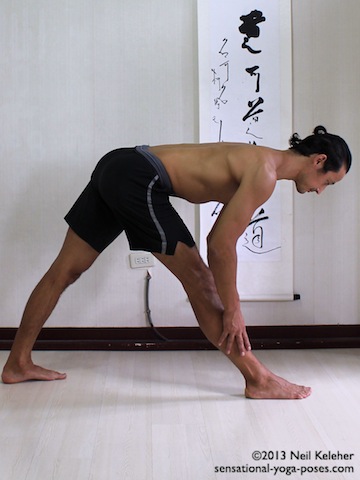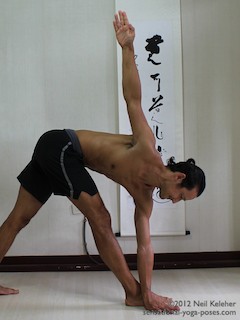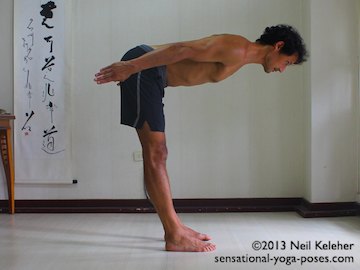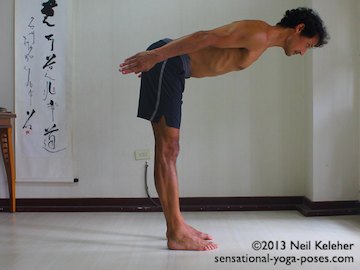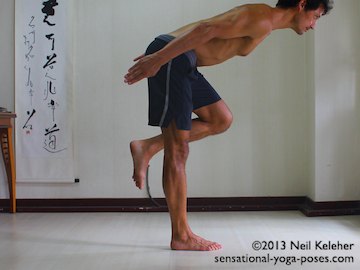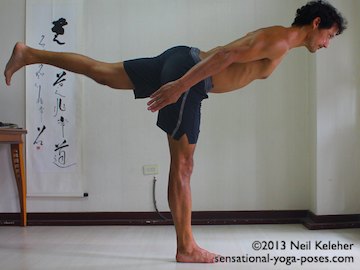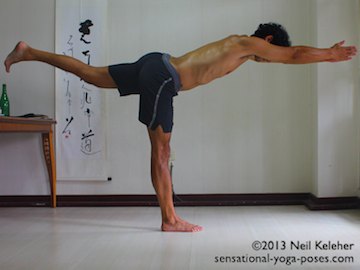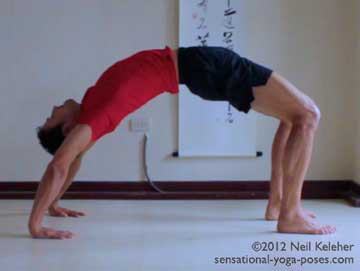It Eccentrically Contracts
(Which Means it lengthens while active)
One of the things that Liz talked about was that it eccentrically contracts.
I really don't like the term eccentric and concentric. I keep having to have to think about what it means.
- Concentric is when the muscle shortens as it contracts (because it is exerting more force than what ever it is working against.)
- Eccentric is when it lengthens while active. And that's one of the things that the psoas does.
It actively lengthens.
But all muscles have this ability.
The Psoas Adjusts Its Length to Maintain Tension
She goes on to say that it doesn't shorten.
Personally I like to think of it as being active and constantly adjusting it's tension, shortening or lengthening as the circumstances require.
It would be like running around an old fashioned tent, constantly adjusting the tensioners on the guy wires to keep the tension in the fabric just right... A better analogy would be a bunch of sailors tightening and loosening "sheets" to keep sail tension just right as the wind varies in strength and direction.
So What's This About The Psoas Falling Back Towards the Spine?
Another interesting point is that she said that the psoas falls back against the spine even while under tension. What the Facebook!
I thought it was a lot of BS and so put it out of my mind, or so I thought.
I've been having back pain for a while and I figured that the psoas was one of the main culprits, though it could be overall body posture or my attempts at learning my body that is actually throwing my body out of whack and my psoas is just stepping in to cover for my inept attempts to learn to drive my body.
(Hey, this is Neil's psoas, I'm working my ass of here, figuratively speaking of course, but can someone tell Neil to lay the facebook off and let us get on with our job, I'm dying for a break here.)
It's a Lumbar Stabilizer Dagnabbit
(Plus it Can Create Balanced Inter-Vertebral Disc Compression)
In Anatomy of Movement (Calais-Germain, B.) the author says that research suggests that the psoas and the spinal erectors may work together to support the lumbar spine from the front and the back.
The psoas is the only muscle that directly attaches to and acts on the front of the lumbar vertebrae.
While the obliques and rectus can have an affect on the Lumbar spine via their ability to stabilize or change the relationship of the ribcage and the pelvis, the psoas is the only muscle that directly attaches to the front of each of the lumbar vertebrae.
And so structurally it makes sense that this muscle be active in stabilizing the lumbar spine.
Pressurizing the Fronts of the Discs
When active it could help in compressing the front of each inter-vertebral disc while the spinal erectors compress the rear.
The result is balanced pressure distribution throughout each individual disc (at least in the lumbar region.)
And so one possible justification for learning to use the psoas as a lumbar stabilizer (or allow it to function properly in this role) is to help reduce the risk of ruptured or slipped disks.
In addition, it could also lead to a more stable lumbar spine as mentioned in Anatomy of Movement.
The Problem With Sitting
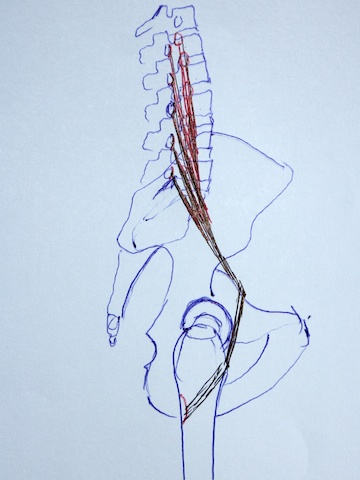
The psoas actually passes to the inside of the thigh bone. In this picture the thigh bone is "transparent." In this standing position the psoas wraps around the front of the pelvis. This actually takes up any slack in the psoas. Can you see that with the thigh 90 degrees forwards it would have a lot of slack.
It is easy to see how the psoas can be useful in supporting the spine while standing. Standing upright it is given operating length, room to contract, by the fact that it is forced to bend around the pelvis.
The problem is while sitting. While sitting with thighs at ninety degrees to the pelvis, it potentially has a lot of slack.
The distance between it's end points might be too short for it to effectively contract.
At least that's what I imagine.
This would also apply in any situation where the legs are at ninety degrees or less to the pelvis such as in standing or seated forward bends, doing good mornings, or v-sits or boat pose.
How Does the Psoas Take Up Its Own Slack?
So what if… the lower fibers can act as a sort of tensioning mechanism for the muscle as a whole?
What if the fibers that attach to the lowest lumbar vertebrae tighten to pull the "psoas sausage" close to the spine removing the slack. At least that was one idea that came to me.
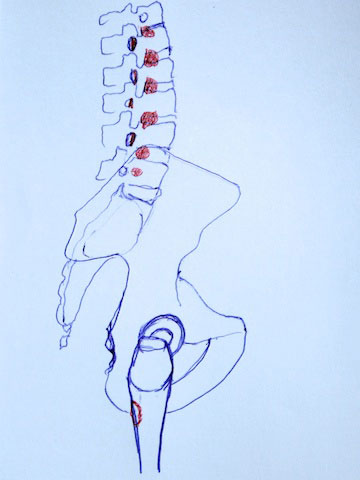
Here I've tried to show, from the side the attachment points of the psoas to the Lumbar vertebrae and T12 (the lowest Thoracic Vertebrae.) The bigger dots show attachments to the sides of the body. The smaller dots show the attachment points of the psoas fascicles to the transverse processes.
Another scenario, which I think is more likely is based on the idea that the psoas has fascicles that attach to the spinous processes (the bits of bone that stick out to the sides of each vertebrae) as well as to the sides of the vertebral bodies (these are the parts of each vertebrae that actually sandwich the inter-vertebral discs.)
What if the fibers that attach to the transverse processes act to pull inwards on the fascicles of the fibers above that attach to the bodies of the vertebrae?
The idea here is that in any situation where the muscle potentially has too much slack to be effective, such as in a thighs forwards hips bent to 90 degrees or less scenario, then the aforementioned fibers that attached to the spinous processes act to pull the bulk of the psoas muscle in towards the spine so that the slack is removed.
The muscle would then have the ability to continue to stabilize the lumbar spine from the front, even when the hips are flexed (or bent forwards.) And it could then continue to act as a hip flexor in such situations if required.
(Which may, in part, be similiar to what Liz Koch was trying to say.)
The Transverse Abdominus Can Help to Create Slack in the Rectus Abdominus
A similiar tensioning mechanism exists in the abdominals.
The transverse abdominus can be activated in different layers.
Imagine dividing the Transverse Abdominus muscle into three belts below the belly button and a single wider belt above the belly button.
It is possible to pull these "belts" in one at a time from bottom to top while exhaling, and a little bit harder to release these belts one at a time from top to bottom while inhaling.
This is the basis of one type of exercise called agni sara.
How is this relevant?
It Makes Diaphragmatic Breathing Easier When the Ribcage is Lifted
If you've ever tried belly breathing with your ribcage sunk down (slouched) you know it is a lot easier than when the ribcage is lifted. Lifting the ribcage ads tension to the rectus abdominus and that makes it more challenging to expand the belly while inhaling.
That is until you pull in the lower one or two belts of the transverse abdominus.
Doing so creates some slack in the upper portion of the rectus making it easier to "belly breath" (or breath diaphragmatically) even with the ribcage lifted. However, instead of breathing so that the whole belly expands, you just expand the upper belly since the lower belly is pulled in.
Taking Up the Slack... Naturally
This is actually the opposite to what I'm suggesting happens with the psoas; muscle fibers engage to create tension, to take up the slack. With the abdominal situation muscle fibers are engaged to create slack. But in both cases muscle contraction is used to vary the tension of another muscle without directly acting on or via a joint.
Chances are, if the muscle is active, this "pulling in of the psoas sausage" happens naturally. So the question then is how to activate it.
How to Consciously Activate the Psoas
(And Feel It Activating)
The exercise that I use for activating the psoas is based on what I've been learning while doing Tai Ji.
Stand with feet about shoulder width apart and parallel. Bend your knees slightly. Check that your knees are pointing in the same direction as your toes.
Focus on feeling your hip joints. Feel your right hip and then your left hip. In both cases relax them.
Move your awareness to your tail bone, the bottom tip of the sacrum. Pull it towards your pubic bone. Try to decrease the distance between your tail bone and your pubic bone. In this case the tailbone and sacrum move slightly relative to the pelvis. This backwards nodding of the sacrum could be called anti-nutation.
Next focus on your pubic bone. Pull it up and back slightly so that your lower back flattens. In this case the sacrum and pelvis tilt back together with the tailbone still being pulled towards the pubic bone.
Working from the bottom upwards feel each of your lumbar vertebrae and the lowermost thoracic vertebrae, six vertebrae in all.
For each vertebrae in turn, imagine you are pulling forwards on it from the inside. Pull forwards and down towards the pubic bone.
Refine the pull so that it originates on either side of each vertebrae. You could also refine it so that it pulls towards points on either side of the pubic bone.
Resist the pull by keeping your lumbar vertebrae in place.(This is a little like popping the pecs. Even though the pecs are being activated the arms don't move.) In this case, even though you are pulling forwards on the vertebrae, the vertebrae don't move.
You may find it easier to activate the pull if you actually focus on moving the vertebrae back slightly, while creating a forward pull on them.
It's All In the Intent
(And In Clearly Understanding What You Are Trying to Do)
In this case some part of your spinal erectors, or other deeper muscles are activating to pull your vertebrae backwards. These muscles are responding to your intent to either keep your lumbar spine still, or to he intent to move your lumbar vertebrae backwards.
The intent with pulling your lumbar vertebrae forwards isn't to pull them forwards, but to create the sensation of pulling forwards. That's how you activate the psoas. And since it is the only muscle that can actually pull individual vertebrae forwards, then chances are when you imagine this pull, and then actually feel it, that then is the psoas activating.
Try to rhythmically activate and then relax the pull.
Activation of the psoas under different conditions
As a lumbar stabilizer the psoas should be able to stabilize the lumbar spine in any position. And it may help, in conjunction with the erector spinae in shaping the lumbar spine.
And so to that end try this muscle activation with different positions for the lumbar spine, i.e. curved forwards, curved backwards, straight.
Also try it with knee straight and slightly bent while standing. Try it while sitting.
The Psoas In Forward Bending and Twisting Yoga Poses
Once you get a feel for pulling creating a forwards pull on your lumbar spine (your abs may or may not activate) you can experiment with creating and maintaining the pull in triangle forward bend.
See if you can isolate the pull to the forward leg side. Also vary the curve of your spine to find the position that feels the best.
And just for the experience, experiment with keeping it active on both sides.
You can also try both single sided activations and activating both sides in twisting triangle.
Can you use the muscle to help you twist your lumbar spine.
(Note that in the past I've written that the lumbar spine isn't designed to twist. It seems that I was incorrect. And that is why I encourage you to experiment for yourself. Find out what works for you.)
In seated forward bend, especially if you are folding deeply at the hips, I'd suggest combining psoas activation with a deep pulling inwards of the transverse abdominus. Rather than just pulling the lower third of the belly inwards, pull in the lower two-thirds or more. But at the same time continue to keep the muscle active by creating a slight forward pull on the lumbars.
A Psoas Stabilized Single Leg Deadlift?
(It Can Turn Into Warrior 3 Yoga Pose)
You can also experiment with it in this set of psoas, hamstrings and gluteal awareness exercises that are in part inspired by the "cross body one arm single leg Deadlift variation" Grey Cook exercise I found in The 4 Hour Body.
It was also inspired by an article on weight lifting. (I thought her analysis of squat was spot on. But what really got me thinking was her mention of dead lifts and the hamstrings.) And of course it was also partly inspired by my own interest in understanding this muscle and the body in general.
To activate the hamstrings, first shift your weight forwards, then pull down on the sitting bones. You can also squeeze your buttocks. The spinal erectors will naturally activate but see then if you can pull with your psoas.
Then try the same with weight on one leg. See if you can activate the psoas just on the standing leg side. Keep the activation with lifted knee bent, and then with lifted leg reaching back.
To make reaching the arms forwards easier, reach forward one arm at a time and then bring the hands together.
Back Bending Yoga Poses, the Transverse Abdominus and Yes, The Psoas
Note that in a standing back bend or even in wheel pose, you may find it helpful to activate the psoas even though the front of the hip joint is opening. You could think of this as "resisted lengthening" or "resisted stretching."
You could also experiment with pulling the lower belly in (as described above) at the same time.
Lengthen Your Spine!!!
One other action that you can do while activating your psoas is focus on making your spine feel long. Think of this as a way of taking out the slack in all parts of the torso. You may find a better ability to feel your body as well as control it.
One Final Note
So why do I still think of the Psoas as a Hip Flexor? Cause I can feel it moving, I can feel it contracting when I do hip flexing actions like front kicking. Actually, I try to deliberately use my psoas in combination with movements of my pelvis. And I'm pretty sure I can deliberately activate it when doing forward bends.
And that's hopefully what some of the tips in this article will help you with. Improve your control of your psoas so that you can actively use it when required.
Published: 2020 08 03
Updated: 2020 11 04


